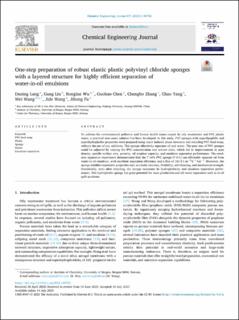| dc.contributor.author | Lang, Daning | |
| dc.contributor.author | Liu, Gang | |
| dc.contributor.author | Wu, Ronglan | |
| dc.contributor.author | Chen, Guohao | |
| dc.contributor.author | Yang, Chao | |
| dc.contributor.author | Wang, Wei | |
| dc.contributor.author | Wang, Jide | |
| dc.contributor.author | Fu, Jihong | |
| dc.date.accessioned | 2023-08-11T11:26:46Z | |
| dc.date.available | 2023-08-11T11:26:46Z | |
| dc.date.created | 2023-07-24T12:10:34Z | |
| dc.date.issued | 2023 | |
| dc.identifier.issn | 1385-8947 | |
| dc.identifier.uri | https://hdl.handle.net/11250/3083591 | |
| dc.description.abstract | To address the environmental pollution and human health issues caused by oily wastewater and PVC plastic waste, a practical zero-waste solution has been developed. In this study, PVC sponges with superlipophilic and superhydrophobic properties were prepared using vapor induced phase inversion and recycling PVC food wrap, without the use of any additives. This sponge effectively separates oil and water. The pore size of PVC sponges could be adjusted by varying the PVC concentration and solvent ratio, which led to improvements in pore density, specific surface area, porosity, oil sorption capacity, and emulsion separation performance. The emulsion separation experiment demonstrated that the 7 wt% PVC sponge (7-0-1) can efficiently separate oil from water-in-oil emulsion, with excellent separation efficiency and a flux of 161.5 L·m−2·h−1·bar−1. Moreover, the sponge exhibits impressive properties such as elastic recovery, flexibility, self-cleaning, and mechanical strength. Remarkably, even after recycling, the sponge maintains its hydrophobicity and emulsion separation performance. This hydrophobic sponge has great potential for mass production and oil–water separation such as in oil spill accidents. | en_US |
| dc.language.iso | eng | en_US |
| dc.publisher | Elsevier | en_US |
| dc.rights | Navngivelse 4.0 Internasjonal | * |
| dc.rights.uri | http://creativecommons.org/licenses/by/4.0/deed.no | * |
| dc.title | One-step preparation of robust elastic plastic polyvinyl chloride sponges with a layered structure for highly efficient separation of water-in-oil emulsions | en_US |
| dc.type | Journal article | en_US |
| dc.type | Peer reviewed | en_US |
| dc.description.version | publishedVersion | en_US |
| dc.rights.holder | Copyright 2023 The Author(s) | en_US |
| cristin.ispublished | true | |
| cristin.fulltext | original | |
| cristin.qualitycode | 2 | |
| dc.identifier.doi | 10.1016/j.cej.2023.144752 | |
| dc.identifier.cristin | 2163214 | |
| dc.source.journal | Chemical Engineering Journal | en_US |
| dc.source.pagenumber | 144752 | en_US |
| dc.identifier.citation | Chemical Engineering Journal. 2023, 471, 144752. | en_US |
| dc.source.volume | 471 | en_US |

